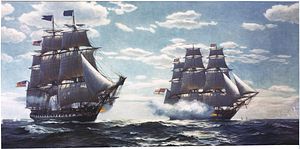The Russian Navy has again moved into the Mediterranean off Syria. There are currently two Russian frigates countering the presence of the U.S. Navy and press focus is on the disparity between the number and size of the vessels. History, however, reminds us that not all missions call for large ships or fleets. Strategically, the Russian Navy’s role as a protector of the fatherland does not require Nimitz or Ford style leviathans.
This limited role, coupled with a struggling economy, has Russian planners favoring low-cost fleets that can move quickly and harass larger flotillas. Currently, planning agencies in Russia are not looking to match the large surface assets of the United States. Moving to modernize its navy, the Russian Defense Ministry is relying on small, easier to produce surface assets. Interestingly, a blueprint for this style navy can be found in the first plans of the U.S. Navy in the 1790s. The nascent U.S. Navy of the late 18th century could not afford large line ships to meet the British Royal Navy in fleet actions, but could pose a threat with well-armed and well-handled smaller vessels.
In a similar situation previous to the War of 1812, Joshua Humphreys was charged to design American fast frigates, carrying heavy armaments capable of defeating any British vessel of 54 guns and harassing the Royal Navy’s larger ships. They were also to be fast enough to chase down convoys and interrupt trade within the British Empire. The success of his design was confirmed in several actions early in the war. In succession, one of those frigates, USS Constitution, defeated HMS Guerriere, Java, Pictou, Cyane, and Levant. The lesson, though, is not just one of speed and armament ratios, but the role of the vessels as an ongoing threat.
During the War of 1812, Royal Navy squadrons were taken from other operations, and tasked with countering the American menace. Assets were diverted in a vain attempt to blockade the American frigates in their home ports. The overwhelming superiority of the U.S. ships against British frigates caused concern in the Admiralty; in response, Secretary of the Admiralty John Crocker issued an order in 1813 to curtail frigate on frigate actions by the British Navy.
Looking at the Russian frigates, a similar strategy may be at work — faster, well-armed ships to counter the overwhelming size of the U.S. Navy and its vessels. At speeds of 30 knots and armed with the newest missile technology, new Russian frigates are both quick and dangerous. The expansion of the fleet awaits the development of domestic gas turbine production; however, ongoing upgrades to older frigates provides Russia with a number of serviceable surface launch platforms at relatively little cost.
Russian weapon systems, including Kalibr and the new Zircon systems, are designed to overwhelm defenses by forcing an enemy to track a number of incoming target at various elevations, directions, and speeds. The goal is to achieve the target with at least one of the weapons and cause damage. As with the early American frigates, this ability to take ships out of action creates a threat the enemy must respond to.
The possibility of multiple surface ships launching a concerted hypersonic missile attack on a U.S. carrier could force a change in the positioning and mission of the U.S. Navy. The loss of a large carrier would deal a devastating blow to U.S. naval operations in any theater of operations or the recall of carriers to positions beyond the effective range of their aircraft in order to avoid loss.
Damage elevators, deck, or catapult, and a carrier quickly becomes an expensive but useless island. Damaged Japanese carriers at Midway were not capable of defending themselves against attack and four of six were lost. Damage to steering or propulsion make a carrier and her sailors a very large target for multiple weapon systems. Again, at Midway, the damaged American carrier Yorktown was torpedoed during repair activities. Critical systems damage forces an entire task force to leave a theater of operations. The USS Franklin in 1945, heavily damaged, took several other ships from the battlefield to protect her as she headed for repairs. One well-placed, or even lucky, missile reaching a modern carrier would require an escort of several destroyers, cruisers, and even submarines, substantially altering the power equation in a theater of operations.
History also shows Russia that a navy made up of small, well-armed vessels can be an international player as it awaits the building of larger vessels, such as new carriers. Again, the history of the American Navy suggests that Russia’s fleet of smaller ships can project power on the international stage. During the First Barbary War (1801-1805) and then the Second (1815-1816), the United States used its frigates as symbols of power in the Mediterranean. The United States would continue to rely on them until larger line ships were available just prior to the American Civil War. The same is being done with the Russian frigates. Russia’s deployment of frigates to the waters off of Syria points to an understanding of this use.
The Russian Navy may be a shadow of its Soviet predecessor, but its rebuilding has begun and the emphasis is on small ships. While it may at first glance seem to be folly to believe small frigate class vessels can challenge the large ships of the U.S. Navy, American naval history itself suggests otherwise.
Robert Cobb is a historian of American ideology, with an interest in the development of military strategy and planning. He has taught courses in American History, the History of Warfare, American Naval History, at a New England private school and as adjunct faculty of Syracuse University.

































